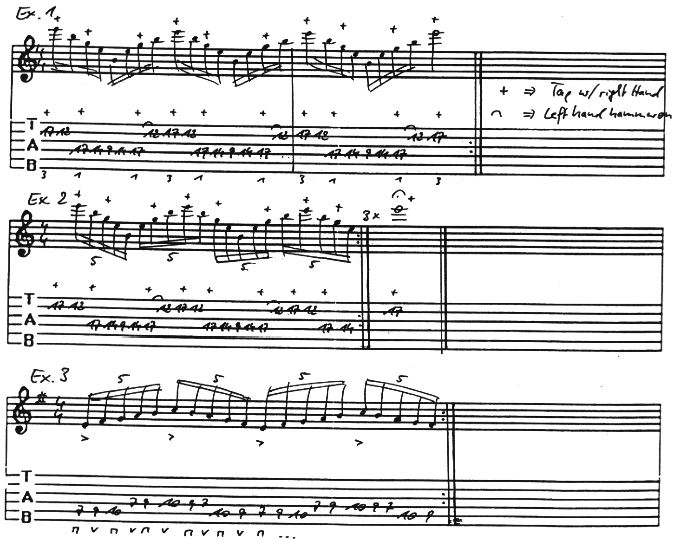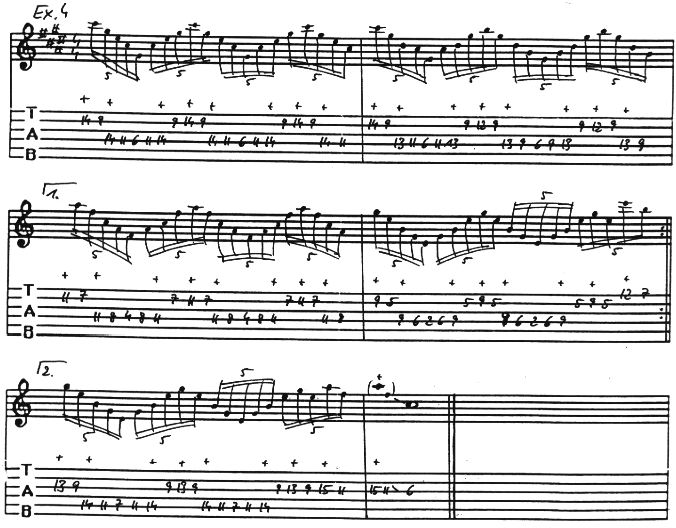Note: If you do not want to read the full concept in detail, scroll down to the bottom of this page and dig right into Lick 4.
When you play a repeating pattern, there are two levels going on at the same time: One level is the number of notes of the repeating pattern and the other level is the number of notes for each beat. If both numbers match, the pattern sounds very comprehensible for the listener, because the pattern starts on a strong beat with each repetition. For example when you play an A minor triad up and down, the repeating pattern would consist of 4 notes:
A minor triad in sixteenth notes:
| A C E C | A C E C | A ...
If you play this in sixteenth notes you have four notes on each beat and with this four note pattern it would sound very comprehensible. Maybe you are into progressive rock and don't want it to sound comprehensible at first listen.
Maybe you want it to sound more interesting or even confusing so that the listener does not understand it immediately and has to hear it more often to fully understand the phrase. You would give him more to discover in your music this way.
This can be done for example by playing the same phrase in quintuplets.
Quintuplets are 5 sixteenth notes per beat and they can be counted in different ways, for example by saying the word "DaLaPiKoLa" which consists of 5 syllables. This may sound silly at first but it helps a lot to understand quintuplets and once you get a feeling for 5 notes per beat you might not need to count them anymore, i mean who counts sixteenth notes?
To get a feeling for quintuplets try playing the simple picking exercise in Ex. 3 to a metronome. It is well suited for this purpose because it consists of 10 notes so it repeats after two beats. Play an accent on the first note of each beat to make it easier to stay in time.
Our example would now sound and look more complicated, but at the same time more interesting:
A minor triad in quintuplets:
| A C E C A | C E C A C | E C A C E | C A C E C | A ...
You can see how the two levels of 4 and 5 notes move and shift against each other: Each beat starts with a different musicial phrase and a different note, giving the listener the impression that you're playing a complicated long line:
| AC E C A | C E C A C | EC A C E | C A C E C | A
Now let's apply this to tapped arpeggios. Check out Lick 1 (Example1):

MP3 - Example 1
Lick 1 is a large E minor arpeggio played slowly and includes string skipping to get the wide intervals. The repeating pattern and the rhythmical pattern are not equal (8 to 4) but they match because the pattern repeats every two beats.
Please be careful with your left hand if you are not used to wide stretches like the one on the D-string and don't do it too long in the beginning. Give your hands time to develop more dexterity!
The notes with crosses above them are to be tapped with the right hand's first and third (or second) finger as indicated. The B on the b-string, twelfth fret is to be hammered on "from nowhere" with the left hand's third finger.
All notes are either hammered-on, tapped or pulled-off. Make sure to mute any unwanted noise: Usually the left hand has to take care of the higher strings while the right hand mutes the lower strings.
Check out Lick 2 (Example 2) to hear how the same sequence sounds in quintuplets and notice how the lick shifts against the beat, resulting in a more interesting sound.
MP3 - Example 2
In Lick 4, I play this technique over a chord progression to outline the chords below:

MP3 - Example 4 - Fast
MP3 - Example 4 - Slow
| C#m | G#sus4 G#m | F# | E |
| C#m | G#sus4 G#m | E | F# |
This part is taken from the solo section of "Stirred Not Shaken", from my second album "Law Of The Jungle". The most interesting part is the second bar where I play through the chord change G#sus4 to G#m. The fourth of G#sus4 is C# which is replaced by the minor third B during the second beat for G#m. This way you can hear the chord change even if the lick is not accompanied by a second guitar or keyboard which is important for example in live performance with a trio format where the guitar is accompanied just by the bass.
I wish you all the best for your musical progress. Please check out the soundclips of my solo CDs "Law Of The Jungle" and "Keeping The Balance" and visit my homepage www.martinbehr.de. Don't hesitate to contact me by e-mail with any questions or comments.
Martin Behr is a guitarist from Germany who has studied at M.G.I. (Munich's Guitar Institute), released two solo CDs, and stays busy with studio sessions.
His latest CD is entitled "Law Of The Jungle", which documents his command of many musical styles, his great technique, his tone and feel.